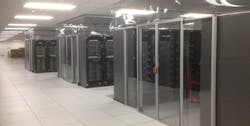Containment Solutions Should Fit the Unique Needs of Each Data Center
In this edition of Voices of the Industry, Chris Williams, Business Development Manager at Emcor Enclosures discusses the positive impact managers and operators will see by selecting a well-designed, high quality containment system for their data center, regardless of size or scale.
Chris Williams, Business Development Manager at Emcor Enclosures
If you could visualize the flow of air within your data center, you might be surprised to see how many variations there are in hot and cold air pockets throughout the facility. Many data centers take a “brute force” approach to cooling, positioning air-conditioning units around the perimeter and cranking them up to achieve a desired average temperature. This approach has been shown to waste a significant amount of energy, require more CRAC units that are needed and still not cool equipment to the levels needed to avoid the risk of equipment failures due to heat.
In fact, our experience has shown that in the typical data center only about 30% of the conditioned air gets to where it’s needed. The result is that operators often use twice as much cooling as they need and still have hotspots. Data center operators pride themselves on building customized environments for their customers but don’t apply the same design principles to their facilities.
Containment using hot or cold aisles is a tried-and-true way to reduce cooling needs by managing airflow within the data center. The approach is relatively straightforward: Servers are arranged in rows with heat vented into a common “hot aisle” and conditioned air blown into the cold aisle. Doors are placed at the end of each passage with a chimney to vent air from the hot aisle back to the CRAC units for recirculation and a low ceiling in the cold aisle to contain chilled air. in the cold aisle.
Containment has been shown to increase cooling capacity by 40% in data centers both large and small, while saving on cooling costs and extending the life of IT equipment. Smoothing out hotspots also enables more equipment to be accommodated per square foot with increased power density. Once containment is implemented, operators often find that they can shut down fully half of their CRAC units. That means containment solutions generally pay for themselves within two years.
Many data center operators understand the benefits of this approach but not the finer points of how to manage air circulation for maximum benefit. Not all containment equipment is the same. A strategy that uses equipment that is customized to the environment can significantly increase savings and minimize wasted space.
One-size-fits-all solutions can leave money on the table. Take the example of end-of-aisle doors. Sliding doors provide for easy entry and exit with the best security. Swinging doors are a great choice when space is limited or for unusual openings. Both offer a clear aisle view. Each can be sized to create a tight fit. That’s important because even small gaps created by a poorly fitted door take a toll on cooling efficiency over time.
The choice of ceiling option also affects performance. Heat-activated shrink-away ceilings made of rigid aluminum frames with FM-rated and UL-listed panels can be used in both cold and hot aisle scenarios. The ceilings automatically fall away in the event of a fire so that suppression systems can work effectively. Mechanical ceilings integrate with existing smoke and heat detection systems to drop panels out of the way if fire suppression is needed. Both are good choices in fixed and consistent aisle configurations.
Curtain containment for hot-aisle chimneys is a good option if there are overhead obstructions that need to be cut around. Curtains are economical and flexible, allowing for a tight air seal to be created in almost any configuration. Materials meet fire ratings needed for most data centers and the curtains are suspended with fusible links that break away in the event of a fire. They also allow for full fire suppression access.
Makers of general-purpose containment products often promote their solutions as being user-installable, however, thermodynamics is a specialized discipline that benefits from the use of expert resources. The best results are achieved by working with a company that handles materials from freight to installation and removes packaging so the customer doesn’t have to. There is no need to train data center staff and installation is certain to provide the tightest fit.
Customers are often surprised to find the custom-configured and installed solutions are no more expensive than off-the-shelf ones and that lead times for delivery are about the same. Containment is a strategy that makes sense for every data center and that pays dividends without large ongoing investments in infrastructure. Choose a provider that will take the time to build a solution that precisely matches your needs.
Chris Williams is Business Development Manager at Emcor Enclosures. Learn how Emcor’s experienced team will work with you to quickly solve your containment problems without sacrificing quality, and continue to improve on the solution once it has been developed.


